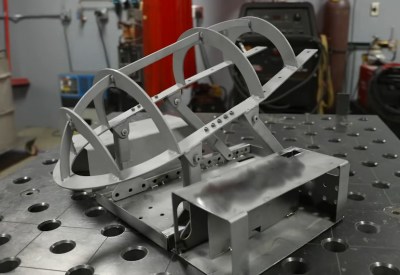They say you learn something new every day, and they’re usually right about that. Today’s tidbit is that just anybody (including [Ian Charnas]) can exchange money for jet engines, no questions asked. Scary, huh? So once [Ian] secured the cutest little engine, he took a poll regarding possible uses for it. Jetpack rollerskating won, that’s obvious enough. So let’s get into those details.
 [Ian] procured this particular jet engine from an outfit called CRX Turbines. It tops out at 98,000 RPM and 30 kg (66 lbs.) of thrust. Essentially, he is pulsing the engine’s ECU with PWM from an Adafruit RadioFruit and controlling it with a pair of stripped drills that are just being used for their convenient grips and switches. One is wired as a dead man’s switch, and the other controls the throttle signal.
[Ian] procured this particular jet engine from an outfit called CRX Turbines. It tops out at 98,000 RPM and 30 kg (66 lbs.) of thrust. Essentially, he is pulsing the engine’s ECU with PWM from an Adafruit RadioFruit and controlling it with a pair of stripped drills that are just being used for their convenient grips and switches. One is wired as a dead man’s switch, and the other controls the throttle signal.
In order to run the thing and test the thrust a bit before strapping it on his back, [Ian] went about this the smart way and welded together a sliding stand. And he didn’t use just any old Jansport backpack, he welded together a frame and roll cage for the engine and attached it to a full-body harness. There’s also a heat shield to keep his backside from catching fire.
At first he tested the jet pack with shoes instead of skates to make sure it was going to behave as he predicted. Then it was time to bust out the roller skates. [Ian] achieved a top speed of 17 MPH before losing his balance, but he knew it could go faster, so he invited some roller derby skaters to try it out. One of them went over 30 MPH! Be sure to check it out in the build and demo video after the break.
If you’re at all familiar with [Ian]’s videos, you know that he usually raffles off the build and gives the money to charity. Well, not this time! That wouldn’t be prudent. Instead, he’s going to choose the best suggestion for what to attach it to, build it, and raffle that off. Hopefully, he stays away from airports with that thing on his back.













